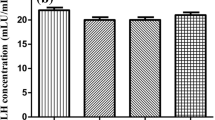Abstract
The delay in appearance of vaginal cornification associated with administration of anordiol (de-esterified anordrin) in the post-ovulatory period was confirmed. Ovarian tissue incubated in vitro for 2 h on the day which, in normal cycles, would be the day of proestrus produced negligible amounts of estradiol even in the presence of androstenedione and human menopausal gonadotropin, despite the appearance of apparently mature follicles in the ovaries. Ovaries of untreated rats produced significant amounts of estradiol when androstenedione was present. Continued incubation for 3 days resulted in significant estradiol production by ovaries of anordiol-pretreated rats in the presence of androstenedione, but less than that of ovaries of control rats. Granulosa cells of immature rats pretreated with diethylstilbestrol (DES) were unaffected by pretreatment with anordrin, whether anordrin was given before or after DES treatment. Taken together, the results indicate that anordiol inhibits development of the capacity for estrogen secretion in maturing follicles without affecting structural development, but that follicles that grow under the influence of high concentrations of estrogen (DES) are unaffected by the presence of anordrin (which is rapidly converted to anordiol in vivo). The latter result suggests that DES treatment bypasses the anordiol-sensitive step in follicular maturation.
Resumé
Le retard dans l'apparition d'une kératisation vaginale liée à l'administration d'anordiol pendant la période post-ovulatoire a été confirmé. Du tissu ovarien mis en incubation in vitro pendant 2 heures le jour du préoestrus d'un cycle normal a produit des quantités négligeables d'oestradiol, même en présence d'androsténédione et de gonadotrophine humaine de femme ménopausée, malgré la manifestation, dans l'ovaire, de follicules apparemment matures. Les ovaires de rates non traitées ont produit des quantités significatives d'oestradiol lorsque l'androsténédione était présent. L'incubation continue pendant 3 jours a entraîné, en présence d'androsténédione, une production significative d'oestradiol par les ovaires chez des rates préalablement traitées à l'anordiol, mais moins que chez les rates témoins. Les cellules de la granulosa de rates immatures prétraitement à l'anordrin, qu'il ait été administré avant ou après les DES. Considérés dans leur ensemble, les résultats indiquent que l'arnodiol inhibe, dans les follicules en maturation, la capacité de sécrétion en oestrogène de se développer, sans compromettre la maturation structurale, mais que la présence d'anordrin (qui se transforme rapidement en anordiol in vivo) ne touche pas les follicules qui se développent sous l'influence de fortes concentrations d'oestrogènes. Ce dernier résultat laisse penser que le traitement au DES ne tient pas compte du stade où la maturation folliculaire est sensible à l'anordiol.
Resumen
Se ha confirmado el retardo en la aparición de una queratización vaginal relacionada con la administración de anordiol durante el período postovulatorio. El tejido ovárico incubadoin vitro durante 2 horas el día del proestro de un ciclo normal produjo cantidades insignificantes de estradiol, aun en presencia de androstanodiona y de la gonadotrofina humana de la mujer menopáusica, a pesar de la manifestación de folículos aparentemente maduros en el ovario. Los ovarios de ratas no tratadas produjeron cantidades significativas de estradiol en presencia de androstanodiona. La incubación continua durante 3 días originó, en presencia de androstanodiona, una producción significativa de estradiol por los ovarios de las ratas tratadas previamente con anordiol, pero menos que en las ratas testigo. Las células de la granulosa de ratas inmaduras tratadas previamente con dietilestilbestrol (DES) no fueron modificadas por el tratamiento previo con anordrin, ya fuera éste administrado antes o después des DES. Considerados en conjunto, los resultados indican que el anordiol inhibe, en los folículos que están madurando, el desarrollo de la capacidad de secreción de estrógeno, sin afectar la maduración estructural, pero que los folículos que se desarrollan bajo la influencia de altas concentraciones de estrógeno (DES) no se hallan afectados por la presencia de anordrin (que se transforma rápidamente en anordiolin vivo). Este último resultado sugiere que el tratamiento con DES no tiene en cuenta la etapa en la que la maduración folicular es sensible al anordiol.
Similar content being viewed by others
References
ChattertonR.T.Jr, MehtaR.R., JencoJ.M., GaynorL.V. and VentonD.L. (1984). Anordrin: biologic studies and potential as a long-acting contraceptive. In ZatuchniG.I., GoldsmithA., SheltonJ.D. and SciarraJ.J., eds,Long-Acting Contraceptive Delivery Systems. Philadelphia: Harper and Row, pp. 550–563
ChattertonR.T.Jr., WaltersN.N. and WallerD.P. (1989). Preclinical studies of anordrin: ovulation inhibition, pharmacokinetics, metabolism, and toxicology. In: MizunoM., ed.,Proceedings of the Satellite Symposium on Hormonal Contraception, International Congress on Endocrinology. Tokyo: Keidanren Kaikan, pp. 25–32
ChattertonR.T.Jr., BermanC. and WaltersN.N. (1989). Anti-uterotrophic and folliculostatic activities of anordiol (2α,17α-diethynyl-A-nor-5α-androstane-2β,17β-diol).Contraception,39, 291–297
MehtaR.R., JencoJ.M. and ChattertonR.T.Jr. (1981). Antiestrogenic and antifertility actions of anordrin.Steroids,38, 679–691
MehtaR.R., JencoJ.M., ChattertonR.T.Jr. and VentonD. (1982). Antagonism of the actions of estrogens, androgens and progesterone by anordrin.Steroids,40, 65–80
SandersM.M. and MidgleyA.R.Jr. (1982). Rat granulosa cell differentiation: Anin vitro model.Endocrinology,111, 614–624
JiaX.-C. and HsuehA.J.W. (1986). Granulosa cell aromatase bioassay for follicle-stimulating hormone: validation and application of the method.Endocrinology,119, 1570–1577
HinegardnerR.T. (1971). An improved fluorometric assay for DNA.Anal. Biochem.,39, 197–201
ChattertonR.T.Jr., ChattertonA.J. and GreepR.O. (1969).In vitro biosynthesis of estrone and estradiol-17β by cycling rat ovaries. Effect of luteinizing hormone.Endocrinology,84, 252–260
ArakiS., ChikazawaK., SekiguchiI., YamauchiH., MotoyamaM. and TamadaT. (1987). Arrest of follicular development in a patient with 17α-hydroxylase deficiency: folliculogenesis in association with a lack of estrogen synthesis in the ovaries.Fertil. Steril.,47, 169–172
RabinoviciJ., BlanksteinJ., GoldmanB., RudakE., DorY., ParienteC., GeierA., LunenfeldB. and MashiachS. (1989).In vitro fertilization and primary embryonic cleavage are possible in 17α-hydroxylase deficiency despite extremely low intrafollicular 17β-estradiol.J. Clin. Endocrinol. Metab.,68, 693–697
Author information
Authors and Affiliations
Rights and permissions
About this article
Cite this article
Lynn, D.E., Chatterton, R.T. & Wentz, A.C. Inhibition of estrogen biosynthesis in the rat ovary by anordrin. Adv Contracept 7, 11–19 (1991). https://doi.org/10.1007/BF01850714
Received:
Accepted:
Issue Date:
DOI: https://doi.org/10.1007/BF01850714




